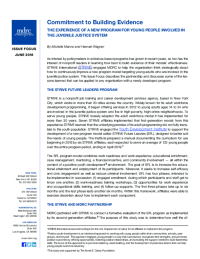Commitment to Building Evidence
The Experience of a New Program for Young People Involved in the Juvenile Justice System

As interest by policymakers in evidence-based programs has grown in recent years, so too has the interest of nonprofit leaders in learning how best to build evidence of their models’ effectiveness. STRIVE International (STRIVE) engaged MDRC to help the organization think strategically about how to continuously improve a new program model targeting young adults who are involved in the juvenile justice system. This Issue Focus describes the partnership and discusses some of the lessons learned that can be applied to any organization with a newly developed program.
The STRIVE Future Leaders Program
STRIVE is a nonprofit job training and career development services agency, based in New York City, which works in more than 20 cities across the country. Widely known for its adult workforce development programming, it began offering services in 2012 to young adults ages 14 to 24 who are involved in the juvenile justice system and live in high-poverty, high-crime neighborhoods. To serve young people, STRIVE loosely adapted the adult workforce model it has implemented for more than 30 years. Seven STRIVE affiliates implemented that first-generation model; from this experience STRIVE learned that the underlying premise of its adult programming did not fully translate to the youth population. STRIVE engaged the Youth Development Institute to support the development of a new program model called STRIVE Future Leaders (SFL), designed to better suit the needs of young people. The Institute prepared a manual documenting the curriculum for use beginning in 2016 by six STRIVE affiliates, each expected to serve an average of 122 young people over the entire program period, ending in April 2019.[1]
The SFL program model combines work readiness and work experience, educational enrichment, case management, mentoring, a financial incentive, and community involvement—all within the context of a positive youth development[2] environment. The goal of SFL is to increase the educational attainment and employment of its participants. Moreover, it seeks to increase self-efficacy and civic engagement as well as reduce criminal involvement. SFL has four phases, intended to be implemented in succession: (1) engaged enrollment, during which participants and staff get to know one another, (2) work-readiness training workshops, (3) opportunities for work experience and occupational skills training, and (4) follow-up supports. The first three phases take up to six months and the last phase lasts another six months. Within this framework, affiliates were able to exercise discretion about how to implement each component.
The STRIVE and MDRC Partnership
MDRC partnered with STRIVE to conduct a formative evaluation of the SFL program as implemented by its second-generation affiliates.[3] The purpose of this study was to determine how well the affiliates were carrying out the model, identify opportunities for strengthening it, and determine the most appropriate next steps for STRIVE to continue building evidence about SFL while continuing to improve the program. To accomplish this, MDRC met regularly with STRIVE’s management, and during the first year of operations, visited each affiliate to conduct semistructured interviews with staff and participants. MDRC also analyzed management information system records to understand participation patterns in the first year. Combined, these activities identified several lessons for STRIVE to consider as it continues to improve the SFL model, find out whether it is working, and provide lessons for the field.
-
Similar to studies of other programs that serve young people, the formative assessment of SFL confirms that it takes time to fully implement a new program model. Components of the model need to be carried out more consistently, and participation in SFL activities needs to be more consistent across activities or affiliates before the model can be considered as being stable or robust.
-
Though STRIVE provided significant training and technical assistance, implementing a program model within an affiliate structure is not straightforward, as other studies of programs for young people have found.[4] Each SFL program was implemented by independently operated affiliates over which STRIVE has little control, each with varying experiences, perspectives, and resources.
-
The SFL program combines many different components — work readiness, work experiences, occupational skills training, case management, and community involvement — which may be hard for any one set of staff to deliver effectively. This suggests that strategic partnerships that capitalize on each organization’s strengths are critical.
-
Monitoring fidelity to the SFL model is an important consideration. A sustainable and scalable approach would make use of management information system data that are easily accessible to both STRIVE and affiliate staff. Regular monitoring of performance metrics could drive targeted technical assistance and coaching. STRIVE has a cloud-based management information system and monitoring practices in place to support such an approach, but work remains to be done to ensure fidelity and promote evidence-building across program locations.
Next Steps for STRIVE and Similar Organizations
STRIVE was deliberate and thoughtful in its staged approach to evidence-building by beginning with a formative study before considering more rigorous forms of evaluation. While this first study of SFL has identified several areas for STRIVE to consider as part of a continuous program improvement process, in 2017 the organization began applying lessons already learned to the implementation of the model by a third generation of affiliates. There are several strategies that STRIVE — and other organizations in a similar situation — could consider: (1) refine the program model based on early implementation experiences; (2) conduct an outcomes study using administrative records to determine how program participants fare once they complete the program; or (3) identify potential bottlenecks or barriers to participants’ success in the program and employ behavioral science techniques to address them. Once program implementation is stable and robust, supported by performance metrics and participants’ outcomes, then an organization can consider moving to a more rigorous evaluation effort.
[1]STRIVE International secured funding from the U.S. Department of Labor for its affiliates to implement the program.
[2]Positive youth development is an intentional approach to working with young people within their communities, schools, peer groups, and beyond. This approach engages young people in a way that is productive, recognizes their strengths, and promotes positive outcomes by offering opportunities, fostering positive relationships, and providing the support needed to build leadership skills. The focus of this approach is to promote resiliency, asset building, and the development of protective factors that can help young people overcome adversity.
[3]This study was supported by The Annie E. Casey Foundation.
[4]Wiegand, Andrew, Michelle S. Manno, Sengsouvanh (Sukey) Leshnick, Louisa Treskon, Christian Geckeler, Heather Lewis-Charp, Castle Sinicrope, Mika Clark, and Brandon Nicholson, Adapting to Local Context: Findings from the YouthBuild Evaluation Implementation Study (New York: MDRC, 2015).






